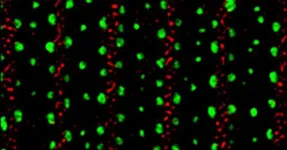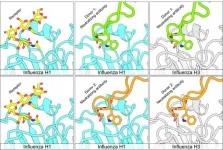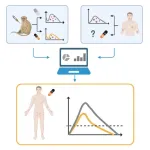(Press-News.org) Through an international collaboration, scientists at St. Jude Children’s Research Hospital leveraged data science, pharmacology and structural information to conduct an atomic-level investigation into how each amino acid in the receptor that binds adrenaline contributes to receptor activity in the presence of this natural ligand. They discovered precisely which amino acids control the key pharmacological properties of the ligand. The adrenaline receptor studied is a member of the G protein-coupled receptor (GPCR) family, and this family is the target of one-third of all Food and Drug Administration (FDA)-approved drugs. Thus, understanding how GPCRs respond to natural or therapeutic ligands is critical for developing new therapies with precise effects on receptor activity. The work was published today in Science.
To understand how a watch works, one might take it apart, piece by piece, and study the role played by each component in its timekeeping function. Similarly, in a protein such as a GPCR, each amino acid might play a different role in how the protein responds to an external signal. Researchers at St. Jude, in collaboration with scientists from Stanford University, the University of Montreal, the MRC Laboratory of Molecular Biology and Cambridge University, investigated the β2-adrenergic receptor (β2AR) by substituting one amino acid at a time to understand the contribution of each amino acid in this receptor to mediate a signaling response.
“Scientists learn how genes contribute to cell function by disrupting them one at a time. We asked, ‘Why don’t we take this one level deeper? Let’s understand how every amino acid contributes to the functioning of a receptor by mutating them, one amino acid at a time,’” said co-corresponding author M. Madan Babu, PhD, from St. Jude’s Department of Structural Biology, Center of Excellence for Data-Driven Discovery director and the George J. Pedersen Endowed Chair in Biological Data Science. “Through evolution, every amino acid in the receptor has been sculpted in some way or another to ensure that it binds the natural ligand, in this case adrenaline, and elicits the appropriate physiological response.”
Finding function in the form
GPCRs are proteins that span the cell’s membrane and connect the outside of the cell to its internal environment by transmitting external signals to the inside of the cell. In the case of the β2AR, adrenaline binds to the GPCR on the part outside of the cell, inducing a response inside the cell.
When a ligand binds, it causes changes in the shape of the receptor, especially in the intracellular region of the receptor where a G protein binds. The binding sites for the ligand and the G protein are on opposite sides of the protein but connect through a complex network of amino acid contacts that span the entire protein. Conformational (shape) changes within the GPCR activate the G protein to trigger a downstream signaling response within the cell. Through effects on multiple tissues and GPCRs, including the β2AR, adrenaline can trigger the fight-or-flight response, such as during an adrenaline surge.
To understand the role of each amino acid in a GPCR, Franziska Heydenreich, PhD, now of the Philipps University of Marburg, the lead and co-corresponding author of this project, mutated each of the 412 amino acids in the β2AR. She then evaluated each mutant’s response to the ligand adrenaline and determined the classical pharmacological properties of efficacy and potency. Efficacy measures the maximum response a ligand can elicit, and potency measures the amount of ligand required to elicit half of the maximum response. The aim was to reveal, on an atomic scale, how each amino acid contributes to these pharmacological properties.
“Surprisingly, only about 80 of the more than 400 amino acids contributed to these pharmacological properties. Of these pharmacologically relevant amino acids, only one-third were located within regions where the ligand or G protein bound to the receptor,” Heydenreich said.
“It was fascinating to observe that there are some amino acids that control efficacy, some that control potency and then there are others that affect both,” Babu said. “It means if you want to make a more potent or efficacious drug, you now know there are specific residues that the new ligand needs to influence.” The researchers also noted that the individual contribution of each residue to efficacy and potency was not equal, implying even more opportunities for fine-tuning drug responses while designing new therapeutic ligands.
“Efficacy and potency have been measured for numerous ligand-receptor signaling systems for several decades. Now we can understand how specific amino acids in a protein’s sequence can influence these pharmacological properties,” Babu explained.
“A fascinating aspect of the results is that potency and efficacy can be regulated independently of each other through distinct mechanisms. This provides a basis for understanding how genetic variation influences drug responses among individuals,” Michel Bouvier, PhD, co-corresponding author from the Department of Biochemistry and Molecular Medicine and General Director of the Institute for Research in Immunology and Cancer of the University of Montreal added.
A beautiful network
Prior research illustrated the structure of both the active and inactive states of the β2AR. Building on this knowledge, the researchers embarked on a new investigation. They explored whether the two-thirds of pharmacologically relevant amino acids previously demonstrated to be not involved in ligand or G-protein binding might play a role in the transition between the active and inactive states of the receptor.
“We systematically started looking at every residue contact unique to the active state,” Heydenreich said, “to understand whether all the amino acids that make an active-state contact are important.”
The researchers developed a data science framework to integrate pharmacological and structural data systematically and revealed the first comprehensive picture of GPCR signaling. “When we mapped the pharmacological data onto the structure, they formed a beautiful network,” said Babu.
“It provided new insights into the allosteric network linking the ligand binding pocket to the G protein binding site that governs efficacy and potency.” Added Brian Kobilka, co-corresponding author and the 2012 Nobel Prize winner in Chemistry from Stanford University School of Medicine.
By understanding GPCR signaling at the atomic level, the researchers are optimistic that they can begin probing even deeper — to see the transient sub-states between the active and inactive conformations and to explore the conformational landscape of proteins.
“We now know which mutants to go after, those that only affect efficacy, potency or both,” Heydenreich said.
“Now, we can perform molecular dynamics calculations and single-molecule experiments on those mutants to reveal the exact mechanisms by which the allosteric network influences efficacy and potency to mediate a signaling response. This is a direction we are pursuing through a St. Jude Research Collaborative on GPCRs that includes PIs from several institutions.” Babu explained.
Apart from these “driver” residues that are involved in mediating active state-specific contacts and affect pharmacology when mutated, Babu and his colleagues intend to probe other key findings revealed by this work. They aim to study “passenger” amino acids that, despite making contacts in the active state, do not affect efficacy or potency when mutated. They are also interested in “modulator” residues that don’t mediate active state-specific contacts but alter pharmacology when mutated. Their data science approach, integrating structural information and pharmacological measurements, isn’t limited to the β2AR. It can be extended to any GPCR to enhance our understanding of the mechanics governing this crucial class of drug targets.
Authors and funding
The study’s other authors include Maria Marti-Solano, University of Cambridge, and Manbir Sandhu, St. Jude.
The study was supported by grants from Marie Skłodowska-Curie Individual Fellowships from the European Union’s Horizon 2020 research (844622, 832620), the American Heart Association (19POST34380839), the National Institutes of Health (R01NS028471), the Canadian Institute of Health Research (FDN#148431), the UK Medical Research Council (MC_U105185859), the Royal Society University (URF\R1\221205), the Isaac Newton Trust [22.23(d)], the Wellcome Trust Institutional Strategic Support Fund, and ALSAC, the fundraising and awareness organization of St. Jude.
St. Jude Media Relations Contacts
Chelsea Bryant
Desk: (901) 595-0564
Cell: (256) 244-2048
chelsea.bryant@stjude.org
media@stjude.org
Rae Lyn Rushing
Desk: (901) 595-4419
Cell: (901) 686-2597
Raelyn.rushing@stjude.org
media@stjude.org
St. Jude Children’s Research Hospital
St. Jude Children’s Research Hospital is leading the way the world understands, treats and cures childhood cancer, sickle cell disease and other life-threatening disorders. It is the only National Cancer Institute-designated Comprehensive Cancer Center devoted solely to children. Treatments developed at St. Jude have helped push the overall childhood cancer survival rate from 20% to 80% since the hospital opened more than 60 years ago. St. Jude shares the breakthroughs it makes to help doctors and researchers at local hospitals and cancer centers around the world improve the quality of treatment and care for even more children. To learn more, visit stjude.org, read St. Jude Progress blog, and follow St. Jude on social media at @stjuderesearch.
END
GPCR structure: Research reveals molecular origins of function for a key drug target
2023-12-21
ELSE PRESS RELEASES FROM THIS DATE:
Structures of Parkinson’s disease-linked proteins offer a framework for understanding how they work together
2023-12-21
Scientists at St. Jude Children’s Research Hospital revealed the complex structure of two Parkinson’s disease-related proteins, both of which are implicated in late-onset cases. Leucine-rich repeat kinase 2 (LRRK2) is a protein kinase that modifies other proteins in a process called phosphorylation; Rab29, a member of the Rab GTPase family that regulates cellular trafficking, modulates the activity of LRRK2. How Rab29 and LRRK2 work synergistically to cause Parkinson’s disease remains ...
Male breast cancer diagnosis fuels groundbreaking treatment tool
2023-12-21
Doctors diagnosed Christopher Gregg, Ph.D., member of the Nuclear Control of Cell Growth and Differentiation Program at Huntsman Cancer Institute at the University of Utah (the U) and neuroscientist and professor of neurobiology and human genetics at the U, with stage 4 metastatic breast cancer in 2018. At that point, he started thinking of ways to improve his treatment.
“The core problem of metastatic cancer is it evolves,” says Gregg. “There may be a treatment that works today but eventually ...
NASA’s Hubble watches ‘spoke season’ on Saturn
2023-12-21
This photo of Saturn was taken by NASA's Hubble Space Telescope on October 22, 2023, when the ringed planet was approximately 850 million miles from Earth. Hubble's ultra-sharp vision reveals a phenomenon called ring spokes.
Saturn's spokes are transient features that rotate along with the rings. Their ghostly appearance only persists for two or three rotations around Saturn. During active periods, freshly-formed spokes continuously add to the pattern.
In 1981, NASA's Voyager 2 first photographed the ring spokes. NASA's Cassini orbiter also saw the spokes during its 13-year-long mission that ended in 2017.
Hubble continues ...
Astronomers detect seismic ripples in ancient galactic disk
2023-12-21
A new snapshot of an ancient, far-off galaxy could help scientists understand how it formed and the origins of our own Milky Way.
At more than 12 billion years old, BRI 1335-0417 is the oldest and furthest known spiral galaxy in our universe.
Lead author Dr Takafumi Tsukui said a state-of-the-art telescope called ALMA allowed them to look at this ancient galaxy in much greater detail.
“Specifically, we were interested in how gas was moving into and throughout the galaxy,” Dr Tsukui said.
“Gas is a key ingredient for forming stars and can give ...
Exercise prescription: Pioneering the "third pole" for clinical health management
2023-12-21
Professor Chen Shiyi's team at Huashan Hospital of Fudan University commented on the concept, policy, development and prospect of exercise prescription in the context of " Health for All", which was published in Research (10.34133/research.0284) under the title of " Exercise Prescription: Pioneering the “Third Pole” for Clinical Health Management".
Modern lifestyles have led to reduced physical activity and a rise in chronic diseases from a young age. Exercise ...
Inside the matrix: Nanoscale patterns revealed within model research organism
2023-12-21
Species throughout the animal kingdom feature vital interfaces between the outermost layers of their bodies and the environment. Intricate microscopic structures—featured on the outer skin layers of humans, as one example—are known to assemble in matrix patterns.
But how these complex structures, known as apical extracellular matrices (aECMs) are assembled into elaborately woven architectures has remained an elusive question.
Now, following years of research and the power of a technologically advanced instrument, University of California San Diego scientists have unraveled the underpinnings ...
Urology treatment studies show increased reporting of harmful effects
2023-12-21
Waltham — December 11, 2023 —
In recent years, clinical trial reports in major urology journals have been more likely to include data on harmful effects of treatments, reports a study in the January issue of The Journal of Urology®, an Official Journal of the American Urological Association (AUA). The journal is published in the Lippincott portfolio by Wolters Kluwer.
"Our analysis finds a marked increase in reporting of potential harms in randomized treatment trials ...
New type of antibody shows promise against multiple forms of flu virus
2023-12-21
Researchers have identified a previously unrecognized class of antibodies—immune system proteins that protect against disease—that appear capable of neutralizing multiple forms of flu virus. These findings, which could contribute to development of more broadly protective flu vaccines, will publish December 21st by Holly Simmons of the University of Pittsburgh School of Medicine, US, and colleagues in the open access journal PLOS Biology.
A flu vaccine prompts the immune system to make antibodies that can bind to a viral protein ...
Despite use of tecovirimat since the beginning of the 2022 mpox outbreak, few data have been published on its antiviral effect in humans
2023-12-21
Despite use of tecovirimat since the beginning of the 2022 mpox outbreak, few data have been published on its antiviral effect in humans; this study predicts the impact of early tecovirimat administration on the time to viral clearance in patients with mpox infection, using an integrative modeling approach combining pre-clinical and clinical data
#####
In your coverage, please use this URL to provide access to the freely available paper in PLOS Biology: http://journals.plos.org/plosbiology/article?id=10.1371/journal.pbio.3002249
Article Title: Early administration of tecovirimat shortens the time to mpox clearance ...
How technology and economics can help save endangered species
2023-12-21
COLUMBUS, Ohio – A lot has changed in the world since the Endangered Species Act (ESA) was enacted 50 years ago in December 1973.
Two researchers at The Ohio State University were among a group of experts invited by the journal Science to discuss how the ESA has evolved and what its future might hold.
Tanya Berger-Wolf, faculty director of Ohio State’s Translational Data Analytics Institute, led a group that wrote on “Sustainable, trustworthy, human-technology partnership.” Amy Ando, professor and chair of the university’s Department of Agricultural, Environmental, and Development Economics, ...








